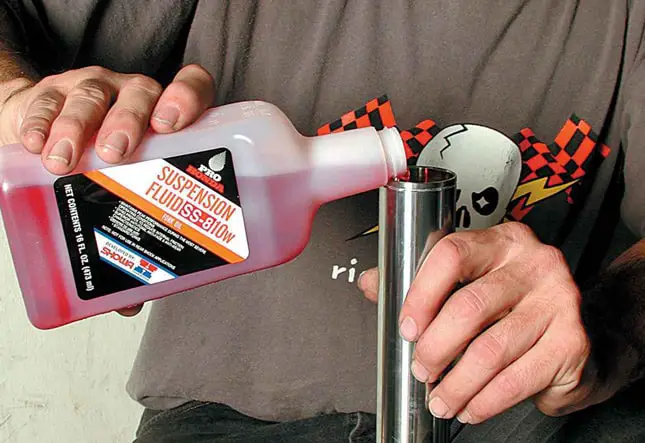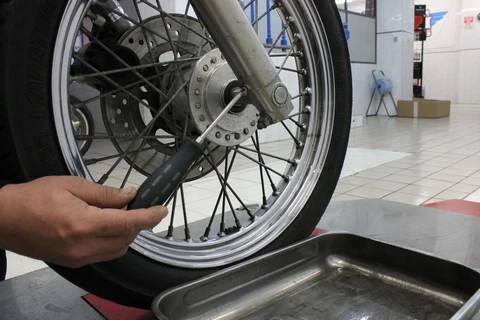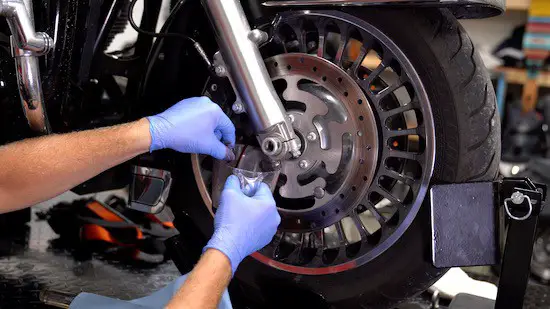Are you looking to learn how to change the fork oil on your Harley Touring? If so, you’ve come to the right place! This step-by-step guide will take you through the process of changing the fork oil on your Harley Touring quickly and easily. With the right tools and knowledge, you’ll be able to keep your bike running smoothly for years to come. So, let’s get started!
To change fork oil on a Harley Touring, lift the front end, remove the fork caps, drain old oil from the fork, then refill with the specified amount and type of fork oil for your model.
What does Fork Oil do in a Harley-Davidson Touring bike?
Harley-Davidson Touring bikes are renowned for their long-distance comfort and smooth rides. These bikes owe a significant part of their performance and handling to an often-overlooked component called fork oil. This vital fluid plays a key role in the front suspension system, ensuring optimal damping and control for a controlled and comfortable ride.
The primary function of fork oil will be to provide damping within the front suspension system. The front forks on a Harley-Davidson Touring bike use a hydraulic damping mechanism where the fork oil flows through valves and ports to control the movement of the fork tubes. The proper viscosity and quality of the fork oil are essential for maintaining consistent damping characteristics, ensuring smooth compression and rebound action.
The quality and condition of the fork oil significantly impact the ride comfort and stability of a touring bike. Over time, fork oil can degrade, losing its viscosity and lubricating properties, resulting in diminished suspension performance. This can result in excessive fork dive during braking, increased sharpness over bumps, and a loss of control and stability. Regularly servicing the fork helps in maintaining optimal suspension performance, contributing to a comfortable and controlled ride.
The choice of fork oil viscosity will allow for suspension adjustability on a Harley-Davidson Touring bike. Different riding conditions and rider preferences might require adjustment to the front suspension’s compression and rebound damping. Fork oil with varying viscosity can be used for fine-tuning the suspension response, tailoring it to specific road conditions or personal riding preferences. You need to consult with a Harley-Davidson dealer or suspension specialist as they can provide guidance on selecting the appropriate fork oil viscosity for desired performance characteristics.
Proper maintenance of the fork oil will be important for the longevity and reliability of the front suspension system. Over time, fork oil can accumulate contaminants, such as dirt, debris, and moisture which can degrade its performance. Regularly scheduled maintenance, including fork oil changes, and seal inspections is important to ensure optimal suspension performance and prevent premature wear and potential component failure. Adhering to the manufacturer’s recommended service intervals and using high-quality fork oil is important for maintaining for longevity and reliability of the front suspension system.

Necessary tools for changing fork oil on a Harley-Davidson touring bike
Maintaining optimal suspension performance will be important for a smooth and controlled ride in a Harley-Davidson Touring bike. One of the key aspects of suspension maintenance will be changing the fork oil. This helps in ensuring proper damping and responsiveness. To successfully carry out this task, it is important to have the right tools at hand. Here are some of the essential tools and parts needed for changing fork oil on a Harley-Davidson Touring bike. This will empower you to maintain the front suspension system and enhance the riding experience.
#1. Fork oil
The first and most important tool needed is appropriate fork oil for your Harley-Davidson Touring bike. It is important to use the recommended type and viscosity of fork oil specified by the manufacturer. The recommended oil will depend on the model and year of the motorcycle, so you should consult the owner’s manual or a Harley-Davidson dealership to make sure that you have the correct fork oil.
#2. Socket and wrench set
A socket and wrench set is important for removing the front wheel, front fender, and other components to access the fork tubes. These tools will allow you to loosen and remove axle nuts, bolts, and various fasteners. Make sure that you have the appropriate sizes for your specific bike model.
#3. Allen wrench set
Harley-Davidson Touring bikes often come with several Allen bolts securing components such as brake calipers, fork caps, and fender brackets. An Allen wrench set with various sizes will allow you to loosen and remove these bolts during the fork oil change process.
#4. Torque wrench
A torque wrench is needed for tightening bolts and nuts to the manufacturer’s specified torque settings. It ensures proper and consistent tightening, avoiding overtightening or undertightening, which can result in component damage or failure. Consult your motorcycle’s service manual for the recommended torque values.
#5. Fork oil level gauge
A fork oil level gauge or also known as a fork oil level tool or syringe is used for measuring and adjusting the correct oil level in the fork tubes. It will allow for precise measurement, ensuring that the proper amount of fork oil is added during the refill process. Different motorcycles might have varying fork oil capacities, so you should refer to the owner’s manual for the correct level.
#6. Fork seal driver
If you’re planning on replacing the fork seals during the fork oil change, a fork seal driver will be needed. This tool will help you properly seat the new fork seals into the fork tubes without damaging them. It ensures a secure fit and prevents oil leaks.
#7. Safety gears
You shouldn’t forget to wear appropriate safety gear, including gloves and eye protection when working on your motorcycle. Additionally, you should also have a clean workspace, rags, and a drain pan to catch and dispose of the old fork oil properly.

Preparation before changing fork oil on your Harley-Davidson Touring bike
When you have to change the fork oil on your Harley-Davidson Touring bike, it will be important to know the process from start to finish. Before you embark on the task of changing fork oil, it will be important to properly prepare your Harley-Davidson Touring bike and follow a systematic approach. Here are some of the necessary preparation steps you need to carry out before you change the fork oil on a Harley-Davidson Touring bike, ensuring a successful and efficient process.
#1. Find a suitable location
Begin by selecting an ideal location to perform the fork oil change. You should look for a well-lit and clean area that offers ample space to work around the bike. A garage or a dedicated workspace will be ideal as it offers protection from the elements and allows you to concentrate on the task at hand.
#2. Park the bike
You should position your Harley-Davidson Touring bike on a stable and level surface, ensuring that it is securely supported. Place the motorcycle in neutral and engage the parking brake to prevent any unwanted movement during the fork oil change process.
#3. Loosen the fork cap
To access the fork oil, you will have to remove the fork cap. Before you do that, you should consult your motorcycle’s service manual or seek guidance from a Harley-Davidson dealership for specific instructions on your particular model. Typically, you will have to use an appropriate wrench or socket to loosen the fork cap. Take care that you do not damage or strip the cap as it has to be reinstalled securely.
How to change fork oil Harley Touring bike: Removing the old fork oil
Removing and replacing the fork oil in your Harley-Davidson Touring bike is an important maintenance task that helps in maintaining optimal suspension performance. Properly draining the old oil is an important step in this process. Here are the steps you need to follow to remove old fork oil from your Harley-Davidson Touring bike, ensuring a smooth and successful procedure.
Step 1: Position the drain pan
You need to place a drain pan beneath the fork tube to catch the old fork oil as it is drained. Make sure that the drain pan is large enough to accommodate the oil and positioned securely to avoid any spills or leaks.
Step 2: Loosen the fork cap
You must refer to your motorcycle’s service manual or seek guidance from a Harley-Davidson dealership for specific instructions on your model. Typically, you will have to use an appropriate socket or wrench to loosen the fork cap. Take care that you do not damage or strip the cap as you remove it as it’ll have to be reinstalled securely later.
Step 3: Drain the old oil
Once the fork cap has been loosened, it will be time to drain the old fork oil. Depending on the model, there are two common methods that you can use – simple drain bolt and remove the fork leg.
The first method is the simple drain bolt. Some models come with a drain bolt at the bottom of the fork leg. If your motorcycle has this feature, you should carefully loosen and remove the drain bolt, allowing the old oil to flow into the drain pan. You must keep in mind that there may be residual pressure, so you should be prepared for a sudden release of oil.
The other method involves removing the fork leg. For models without a drain bolt, the entire fork leg will have to be removed. Loosen the lower pinch bolts and axle bolts for detaching the fork leg from the bike’s front end. Then, you should slowly lower the fork leg to drain the oil into the drain pan. Take care that you prevent any damage or scratches to the fork leg during this process.
Step 4: Allow complete drainage
Make sure that the old fork oil is fully drained from the fork tube before you proceed to the next steps. Patience will be crucial during this step to allow all the oil to follow out completely.
How to change fork oil Harley Touring bike: Refill the fork oil
Once you have removed the old fork oil from your Harley-Davidson Touring bike, the next step would be to refill the fork oil with new oil. Here are the steps you will need to carry out to refill the fork oil in your Harley-Davidson Touring bike, ensuring a successful and efficient process.
Step 1: Measure the fork oil level
First, you will need to consult your motorcycle’s service manual or seek guidance from a Harley-Davidson dealership for the recommended fork oil level. You should make use of a measuring device to measure the appropriate amount of fork oil needed for each fork tube. Make sure that the measuring device is clean and free from any contaminants.
Step 2: Pour new oil
Making use of a funnel, you should carefully pour the measured amount of fresh fork oil into each fork tube. Take care that you avoid any spills or overfilling, as an incorrect oil level could affect suspension performance.
Step 3: Replace the fork cap
Once the new oil has been poured, you need to clean up the fork cap threads and apply a small amount of oil or thread lock compound (if specified by the manufacturer). You need to carefully thread the fork cap back onto the fork tube, ensuring that it is aligned properly.
Step 4: Tighten the fork cap
Using an appropriate socket or wrench, you should tighten the fork cap to the manufacturer’s recommended torque specifications. Be cautious that you do not overtighten the cap as it could damage the threads or lead to other complications. You should be consulting your motorcycle’s service manual or seek guidance from a Harley-Davidson dealership for the correct torque value.
Step 5: Clean and inspect
Wipe away any oil spills or drips using rags or absorbent materials. You need to inspect the area around the fork cap for any signs of leakage. If there are any leaks, you must check the tightness of the cap and sealing surfaces, and address any issues accordingly.
Step 6: Repeat the same for the other fork tubes
You need to follow the same steps outlined above and refill the oil in the other fork tube. Make sure that the measurements, pouring, and tightening are performed accurately and consistently.
Final steps after changing fork oil on your Harley-Davidson Touring bike
After you have successfully changed the fork oil on your Harley-Davidson Touring bike, there are certain final steps that you should carry out to complete the process and make sure that your bike is in optimal condition. Here are some of the final steps to carry out after changing the fork oil, allowing you to wrap up the fork oil change and get back on the road with confidence.
Step 1: Replace the front wheel
Once you have finished changing the fork oil, it’ll be time to reinstall the front wheel. You need to align the wheel with the fork legs and insert the axle through the wheel and fork leg. Securely tighten the axle nut or bolts using the appropriate socket or wrench. Make sure that the wheel is properly aligned and centered within the fork legs, allowing for smooth and balanced operation.
Step 2: Test ride your bike
Before you take your Harley-Davidson Touring bike out on the open road, it’ll be important to perform a test ride to evaluate the newly serviced front suspension. Begin by riding the bike at a slow pace in a controlled area, checking for any abnormalities or unusual noises. You should gradually increase your speed, paying close attention to your motorcycle’s handling and responsiveness. Test the front suspension’s compression and rebound by riding over different surfaces, including bumps and potholes, to ensure that the fork oil change has resulted in improved suspension performance.
Step 3: Check for leaks
After the test ride, you need to park your bike on a level surface and inspect the fork legs and surrounding areas for any signs of oil leaks. Carefully examine the fork seals, fork tubes, and fork caps for any oil residue or drips. Leaks can indicate a faulty seal or improper installation of the fork cap. If you’re noticing any leaks, you must address them promptly by seeking professional assistance or referring to the manufacturer’s guidelines.
Step 4: Final maintenance check
While you’re checking for leaks, you should take the opportunity to perform a final maintenance check on your Harley-Davidson Touring bike. Make sure that all the bolts, fasteners, and components related to the fork assembly, like brake calipers and fender brackets, are securely tightened.
Inspect other critical areas of the bike, including the tires, brakes, and lights to ensure they are in good working condition. Moreover, you should verify that your bike’s suspension settings, such as preload and damping, are properly adjusted as per your preferences and the manufacturer’s recommendations.

Essential tips to remember when changing for oil on your Harley Touring bike
Changing the fork oil on your Harley-Davidson Touring bike regularly is an important maintenance task. Doing this will ensure optimal suspension performance and an overall smooth ride. To ensure a successful and efficient fork oil change, it’ll be important to keep certain tips in mind. Here are some of the valuable tips that you should remember when changing fork oil on your Harley-Davidson Touring bike, helping you achieve the best results and enhance your riding experience.
#1. Consult the owner’s manual
You must always refer to your bike’s owner’s manual for specific instructions and guidelines. Different models might have variations in the fork oil change process, so it’ll be important to follow the manufacturer’s recommendations to ensure proper procedures are followed.
#2. Cleanliness will be key
You should be maintaining a clean and organized workspace throughout the fork oil change process. Dirt and debris can contaminate the fork oil and compromise suspension performance. You need to clean the fork tubes, caps, and surrounding areas before you remove them to prevent any foreign substances from entering the forks.
#3. Measure oil accurately
Proper measurement of the fork oil will be important for achieving the desired suspension performance. Make use of a measuring device, such as a fork oil level gauge or syringe, to measure and pour the correct amount of fork oil specified by the manufacturer. Accuracy in measuring helps ensure consistency and optimal suspension function.
#4. Take time to drain completely
You need to allow the old fork oil to fully drain from the fork tubes before proceeding. Patience is important for ensuring that all residual oil is removed, providing accurate measurements, and preventing oil contamination.
#5. Inspect fork seals and bushings
When changing the fork oil, you need to take the opportunity to inspect the condition of the fork seals and bushings. You must look for any signs of wear, leaks, or damage. If you’re noticing any issues, it is advised that you replace the seals or look for professional assistance to avoid future problems.
#6. Torque fork cap properly
When you’re reinstalling the fork cap, make sure that it is tightened to the manufacturer’s recommended torque specifications. Overtightening could damage the cap or threads while undertightening might result in leaks or poor performance. You must refer to the service manual for the correct torque values and use a torque wrench for accuracy.
#7. Perform a test ride
After you have completed the fork oil change, take your bike out for a test ride to assess the suspension’s performance and feel. Pay close attention to your bike’s handling, responsiveness, and comfort. If you’re noticing any issues or abnormalities, you must address them promptly to ensure a safe and enjoyable ride.
FAQs
What is fork oil and why is it important?
Fork oil is a type of hydraulic fluid that is used in motorcycle front forks to absorb and dampen the shock from bumps and uneven terrain. This helps to provide a smoother ride by reducing the impact of bumps on the rider. It is important to change the fork oil in a Harley-Davidson Touring model regularly to ensure optimal performance and safety.
How often should I change my fork oil on a Harley-Davidson Touring model?
It is recommended to change the fork oil in a Harley-Davidson Touring model every 10,000 to 20,000 miles, or every two years, whichever comes first. This will help ensure optimal performance and safety.
What is the best type of fork oil to use in a Harley-Davidson Touring model?
The best type of fork oil to use in a Harley-Davidson Touring model is a high-quality, low-viscosity hydraulic oil that is specifically designed for use in motorcycle front forks. This type of oil will help to provide a smoother ride and improved performance.

